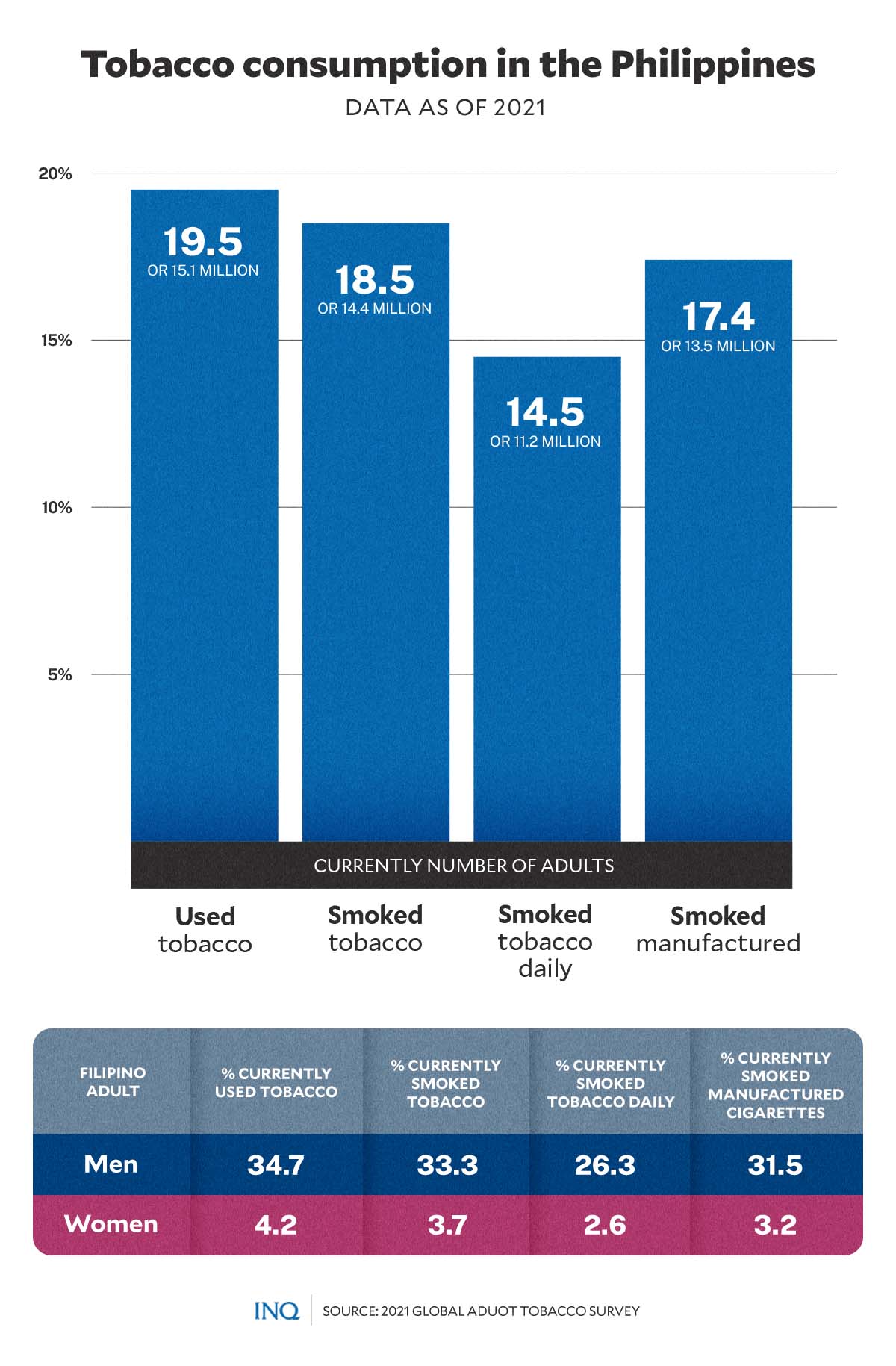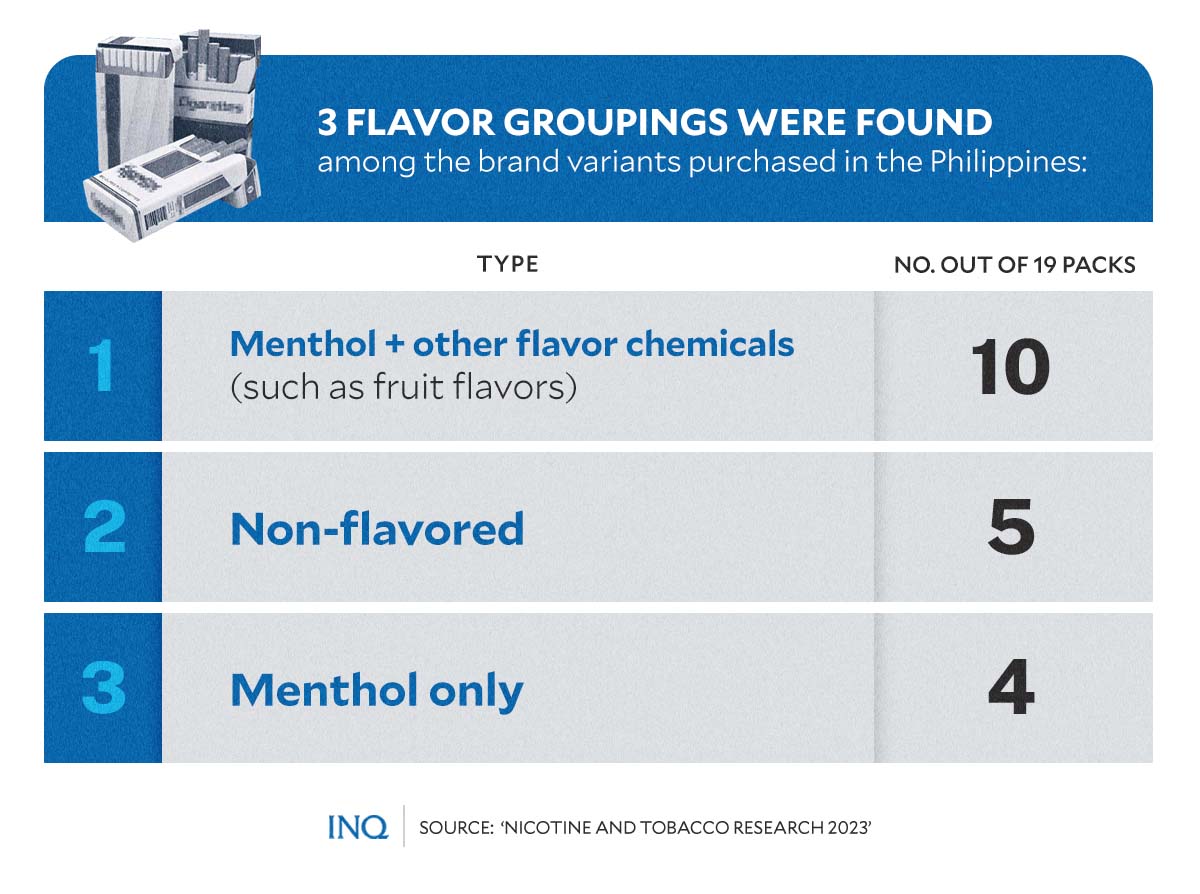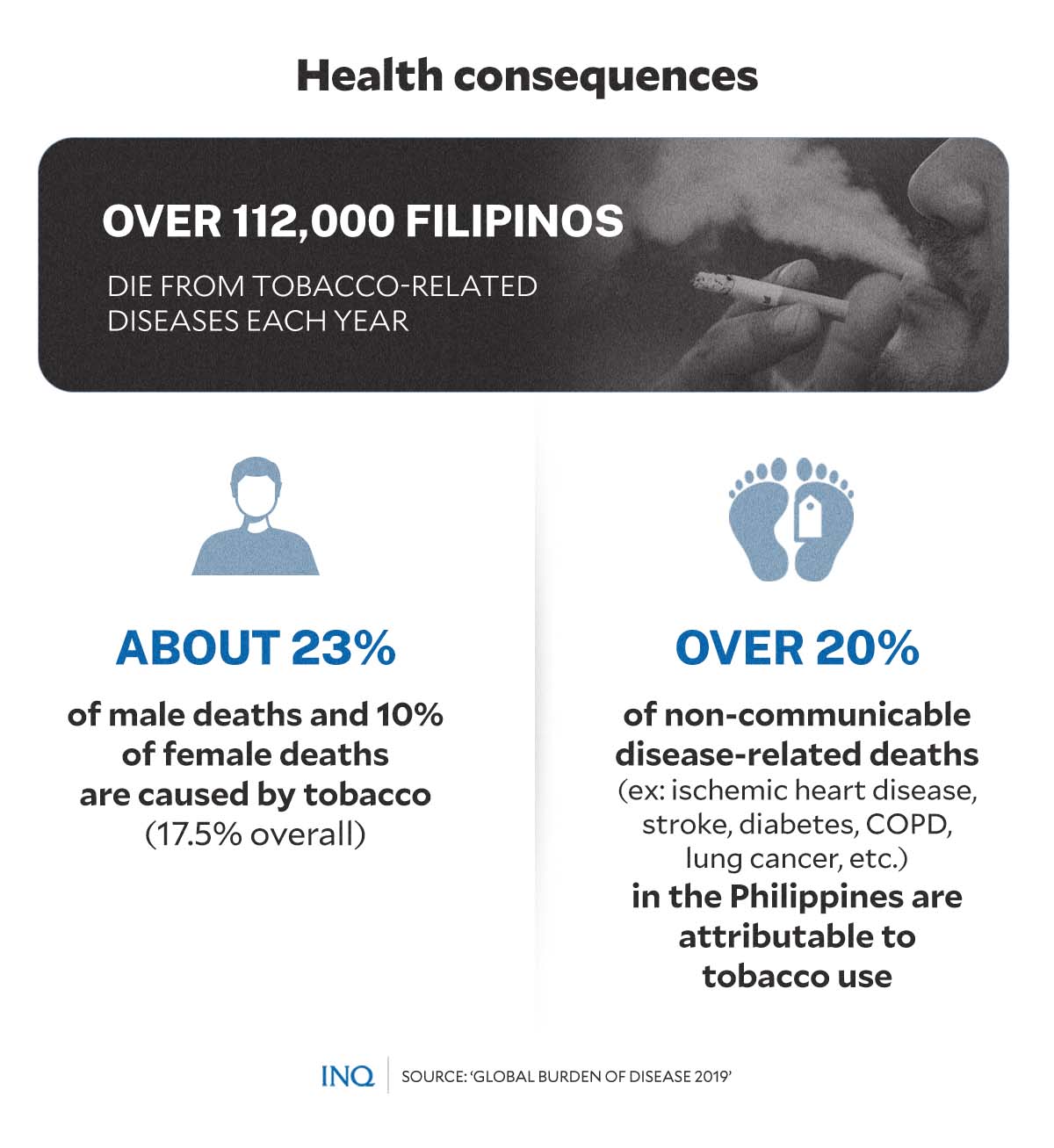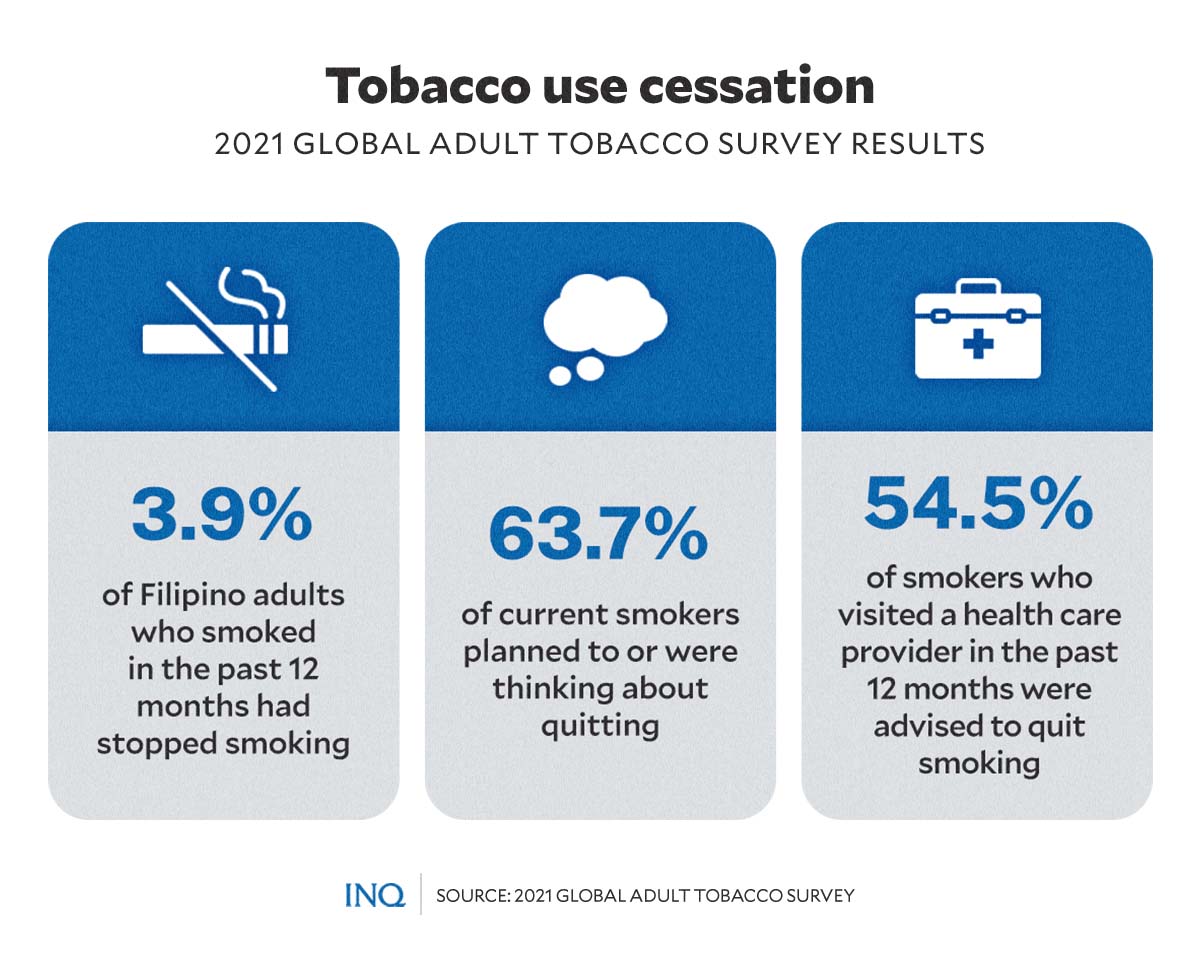Flavor chemicals: Culprit behind PH ‘tobacco epidemic’
MANILA, Philippines—In a “first of its kind” study, scientists linked flavor chemicals found in cigarettes sold in the Philippines to the products’ appeal among many adult and young Filipino consumers.
In a recent study, researchers at the Institute for Global Tobacco Control (IGTC) at the Johns Hopkins Bloomberg School of Public Health and Portland State University analyzed the chemical composition of cigarette brands available in the Philippine market.
“Tobacco product flavors can increase product appeal, adolescent initiation and experimentation, and difficulty quitting,” the researchers said.
“There are no published reports to our knowledge on the levels of flavor chemicals in the cigarettes sold in [the Philippines],” they added.
The Philippines is a signatory to the World Health Organization Framework Convention on Tobacco Control (FCTC), whose guidelines for implementation state:
Article continues after this advertisement“From the perspective of public health, there is no justification for permitting the use of ingredients, such as flavoring agents, which help make tobacco products attractive.”
Article continues after this advertisementStill, researchers noted that flavored tobacco products remain unrestricted in the country despite the high smoking prevalence among Filipinos aged 15 and older. Results of the analysis likewise revealed that tobacco companies in the country continue to offer cigarette products with a range of flavors.
‘Appeal-enhancing flavor chemicals’
The study determined and compared the presence and levels of 180 flavor chemicals found in cigarettes sold in the Philippines.
Detailed analysis revealed that three flavor groupings were found among 19 brands purchased in the country in 2020:
- menthol + other flavor chemicals (such as fruit flavors): 10 out of 19 sample packs
- non-flavored: 5 out of 19 sample packs
- menthol only: 4 out of 19 sample packs
Researchers noted that menthol existed in 74 percent—or 14 out of 19—sample packs. Menthol was also the highest level of flavor chemical detected among all brands — up to 18.4 milligrams per stick.
“The market share of menthol cigarettes sold in the Philippines is among the largest in the world, with the 2015 Philippines Global Adult Tobacco Survey (GATS) reporting that over half (52%) of people who smoke manufactured cigarettes last purchased menthol cigarettes,” the IGTC said in a statement.
“Menthol can make cigarettes more palatable, and other studies have shown that flavors in general (and menthol specifically) can contribute to a lower likelihood of quitting,” it added.
The analysis also found that cigarettes in the 12 packs in the sample, around 63 percent, had flavor “technologies” such as flavor capsules or flavor threads, which — as explained by the researchers — allow consumers to control the release of flavor chemicals.
“[A] marketing differentiator that can further contribute to appeal among consumers,” the researchers said.
A separate study by the IGTC at the Johns Hopkins Bloomberg School of Public Health and Tobacco Control described flavor capsules as crushable gelatine capsules filled with a flavoring liquid embedded into the cigarette filter.
Researchers of that study noted that capsules would release flavors once pressed, giving the users the “ability to ‘control’ their smoking experience.”
Flavors entice young people
Researchers of the study explained that flavor capsules and threads that were also found in sample cigarettes are usually used to appeal to new consumers.
“Findings from the chemical analysis indicate that products containing flavor chemicals and flavor delivery technology encompass a range of flavor levels (including significant levels) that could contribute to appeal to a broad spectrum of consumers,” the researchers said.
“Manufacturers can manipulate the level of menthol in cigarettes to maximize appeal across a range of consumer taste preferences (for example, raising the level for individuals who may prefer variants with higher menthol levels), increasing the potential for more people to start smoking,” they added.
The researchers further noted that flavor chemicals, including fruit flavors, menthol and clove, and flavor capsule cigarettes, appeal to young people.
“Filipino young adults even liken flavor capsule cigarettes to candy,” the researchers added.
A previous IGTC study noted that tobacco companies use marketing strategies to further promote their products through packaging design features that heavily highlight flavors, specifically targeting young adults who smoke and young people who have recently initiated smoking.
The study focused on identifying key cigarette pack design features that are attractive to younger people and the perceptions of pack features that communicate flavor among young adults who smoke.
Results of the focus group discussions showed that young adults, who smoke, from the Philippines could easily identify flavored capsule cigarettes through imagery on cigarette packs.
Most focus group members from the country also agreed that flavored cigarettes and flavor capsules are mostly used and intended for young people and those interested in smoking.
READ: Tobacco packaging: Getting PH youth hooked on smoking, vaping
The researchers noted that flavored cigarettes, considering the packaging designs, might be contributing to smoking initiation among young adults.
Curbing tobacco epidemic in PH
According to data from the 2021 Global Adult Tobacco Survey (GATS), around 15.1 million Filipino adults use tobacco, and 14.4 million Filipino adults smoke tobacco. At least 11.2 million adults in the country smoke tobacco daily.
These lead to numerous health consequences. Each year, over 112,000 Filipinos die of tobacco-related diseases — with about 23 percent of male deaths and 10 percent of female deaths caused by tobacco.
More than 20 percent of non-communicable disease-related deaths — such as ischemic heart disease, stroke, diabetes, COPD, and lung cancer — are likewise linked to tobacco use.
While smoking rates in the country have decreased since 2010, studies found that it has fallen behind the goal of a 30 percent reduction in smoking by 2025.
The researchers stressed that a comprehensive flavor ban, including all flavors in all cigarette components, such as flavor capsules and threads, should be implemented to reduce cigarette sales and promote smoking cessation in the country.
“Flavored tobacco products are a culprit in extending the tobacco epidemic, making cigarettes appealing to consumers — including young people — and more difficult to quit,” explained Lauren Czaplicki, a scientist at IGTC and co-author of the study.
“Fortunately, by banning and removing flavored tobacco products from the market, countries can successfully counter the tobacco industry’s sugar-coated, predatory marketing tactics,” Czaplicki added.




